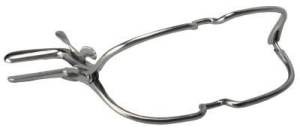

MedFriendly®


Gag (Medical Device)
Gag has several definitions in the field of medicine. It
primarily means to make an effort or attempt to vomit.
It can also mean to cause oneself or someone else to
attempt to vomit. This form of gagging often occurs in
an eating disorder known as bulimia nervosa which is
characterized by binge eating and purging. The purging
often (but not always) occurs via self-induced vomiting
which is where the gagging comes in. Gagging can
sometimes be used to refer to nausea or vomiting.
A dental gag device.
FEATURED BOOK: Medical Device Development: Regulation and Law
In dental surgery or other surgery of the mouth and throat, a gag is a device placed
between the teeth to hold the jaws open to provide easier access to the targets of
surgery. Surgical gags can also force the mouth open more than it would open naturally
because of dislocation of a cartilage plate in the jaw joint. Cartilage is a type of soft,
flexible tissue that helps form many important body structures. One form of surgical gag is
a Jennings gag, which is a metal structure that has a ratchet on one side.
There is another gag known as a Whitehead gag which is also made of metal and has a
ratchet on each side. The metal frames of this gag have hinges that wrap around the front
part of the personís head and contain parts that are bent to fit the personís front teeth.
The jaws are separated to hold the mouth open when the frames are spread apart. The
ratchet devices adjust the degree of separation.
"Where Medical Information is Easy to Understand"™
Someone with a gag in place will not be able to speak, which is the
other definition of gag as a verb (i.e., to stop from speaking). When
someone is gagged to prevent speech, the movement of the tongue,
jaw, and lips will be restricted. If someone tries to speak with a gag
in place, load moaning sounds can still be heard. Some gags can
still pushed out by the wearer by moving the jaw around and pushing
outwards with the tongue.
In non-medical uses, gags are sometimes used by criminals and can
cause death by suffocating the victim. In those settings, the more
effective a gag prevents speech, the greater the potential harm
there is to the personís health.
Gags can be harmful if they are pushed too far down the mouth/throat (often known as stuff gags), which
restricts breathing. However, not all gags work by being pushed into the mouth. For example, some gags
cover the mouth such as duct tape or a cloth tied behind the back of the head. If an over-the-mouth (OTM)
gag covers the mouth and the nose simultaneously, it can also lead to suffocation. These are the most
dangerous type of gags. OTM gags are also known as detective gag due to their early use in detective
stories). The risk of suffocation increases if the person has a health condition that restricts breathing such
as the common cold or chronic obstructive pulmonary disease (COPD). COPD is a general term for
diseases characterized by long-term or permanent narrowing of small airways connected to the lungs.
In legal settings, gags have been used to silence defendants who will not stop verbally disrupting the
court. Sometimes, gags are used not for the purpose of gagging but to keep harmful airborne materials out
of the lungs or to keep the airway open during medical emergencies. Gag comes from the Middle English
word "gaggen" meaning "gag." The word is based on the sound one makes while gagging.















